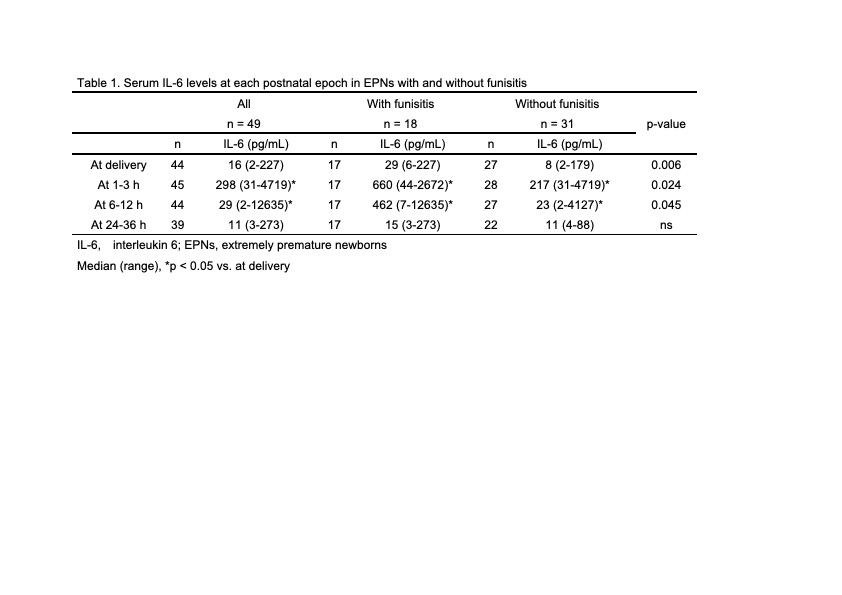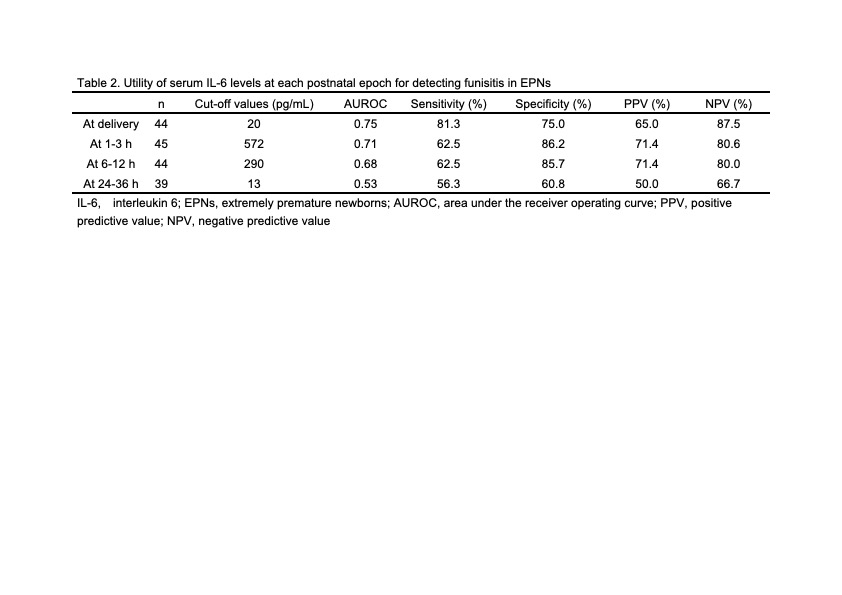Neonatal Infectious Diseases/Immunology
Neonatal Infectious Diseases/Immunology 1
650 - Early changes of serum IL-6 levels in extremely premature newborns may detect fetal inflammation
Saturday, April 29, 2023
3:30 PM - 6:00 PM ET
Poster Number: 650
Publication Number: 650.24
Publication Number: 650.24
Sota Iwatani, Hyogo Prefectural Kobe Children's Hospital, Kobe, Hyogo, Japan; Takao Kobayashi, Hyogo Prefectural Kobe Children's Hospital, Kobe, Hyogo, Japan; Makiko Yoshida, Hyogo Prefectural Kobe Children's Hospital, Kobe, Hyogo, Japan; Seiji Yoshimoto, Hyogo Prefectural Kobe Children's Hosipital, Kobe, Hyogo, Japan

Sota Iwatani, MD, PhD (he/him/his)
Chief Physician
Hyogo Prefectural Kobe Children's Hospital
Kobe, Hyogo, Japan
Presenting Author(s)
Background: Fetal inflammatory response syndrome (FIRS) is defined by elevated levels of inflammatory cytokines circulating in fetal blood, and may result in preterm delivery and subsequent morbidities. Cord serum interleukin-6 (IL-6) level has been reported to be a better indicator of FIRS; however, few reports have focused on changes in serum IL-6 after birth in preterm newborns.
Objective: To characterize changes in serum IL-6 levels in extremely premature newborns (EPNs, < 28 wks' gestation) with and without fetal inflammation.
Design/Methods: In this single-center study, EPNs delivered at Hyogo Prefectural Kobe Children's Hospital between March 2020 and February 2022 were retrospectively studied. At our hospital, measurements of serum IL-6 levels are routinely performed at delivery, 1-3, 6-12, and 24-36 hours of life by electrochemiluminescence (Cobas e 411, Roche, Mannheim, Germany). Enrolled infants were devided into two groups based on the absence or presence of funisitis, the histlogic counterpart of FIRS. Receiver operating curves (ROCs) were then constructed to determine IL-6 threshold levels at each postnatal epoch for detecting the presence of funisitis.
Results: Among the 49 enrolled EPNs, serum IL-6 measurements were performed in 44, 45, 44, and 39 at delivery, 1-3, 6-12, and 24-36 hours of life. Overall, serum IL-6 levels were significantly elevated at 1-3 (298 [31-4719] pg/mL) and 6-12 (29 [2-12635] pg/mL) hours of life, then returned to at-delivery levels at 24-36 hours of life (Table 1). When comparing serum IL-6 levels at each postnatal epoch between the EPNs with and without funisitis, levels at delivery, 1-3, and 6-12 hours of life were significantly higher in the EPNs with funisitis. Serum IL-6 cut-off values at delivery, 1-3, 6-12, and 24-36 hours of life for the presence of funisitis were 20, 572, 290, and 13 pg/mL with area under ROCs of 0.75, 0.71, 0.68, and 0.53, respectively (Table 2).
Conclusion(s): Serum IL-6 levels in EPNs significantly increase early after birth, then returned to at-delivery levels by 24-36 hours of life. Therefore, detection of FIRS using serum IL-6 levels based upon postnatal age-dependent cut-off value is warranted.


